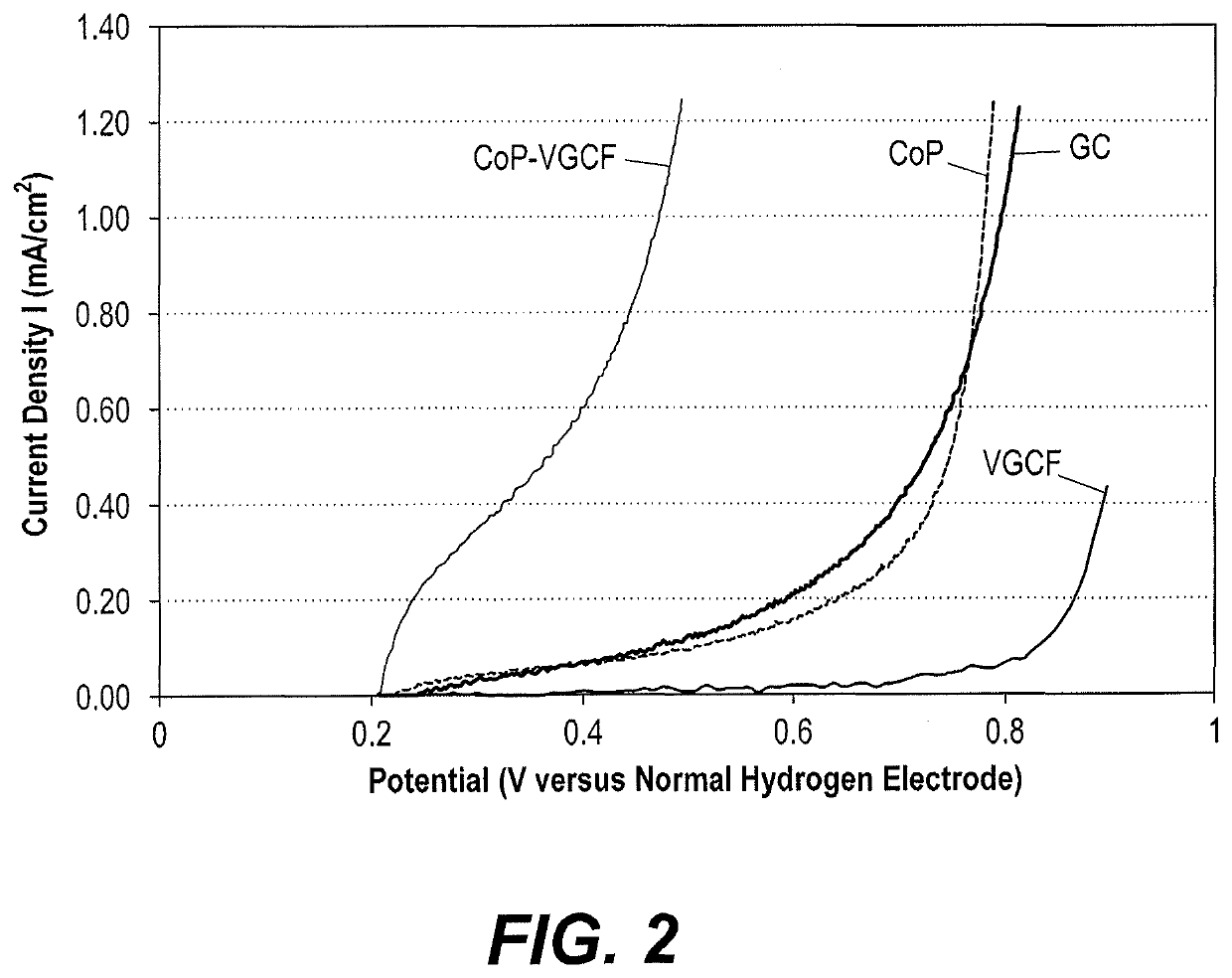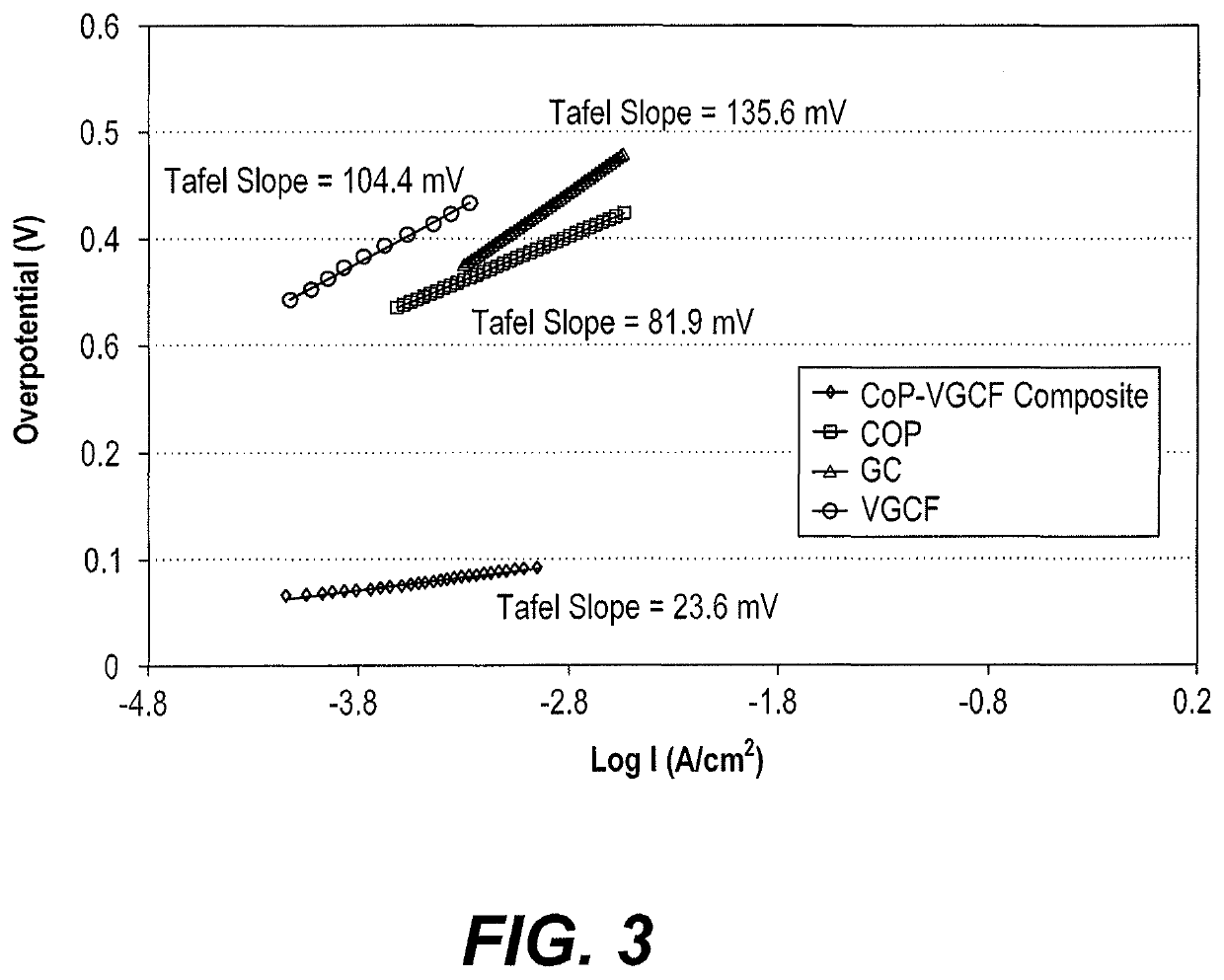Porphyrin-based catalysts for water splitting
a technology of porphyrin-based catalysts and water splitting, which is applied in the direction of physical/chemical process catalysts, separation processes, cell components, etc., can solve the problems of low efficiency, infeasibility of current catalysts, and high cost of noble metal and transition metal oxide catalysts. , to achieve the effect of increasing the red-shift effect, good electrocatalytic activity, and high electronic conductivity
- Summary
- Abstract
- Description
- Claims
- Application Information
AI Technical Summary
Benefits of technology
Problems solved by technology
Method used
Image
Examples
example 1
Synthesis of Porphyrin Catalysts
[0019]The targeted-porphyrins may be prepared using a one-pot, multi-step approach. Generally, a mixture of equimolar quantity of pyrrole and selected aldehydes in dimethylformamide (DMF) was heated at 100° C. under argon atmosphere. Then, a similar molar quantity of p-toluenesulfonic acid (PTSA) was added, and the reaction mixture was heated up gradually to 140° C. and kept at this temperature for one hour. The obtained dark violet solution was left to cool to room temperature. Then the dark violet solution was poured into cooled water / triethylamine (TEA) (5%) and left for 30 min. with stirring. The resulting solid precipitate was filtered, washed several times with water, air dried and purified by column chromatography (CHCl3 / MeOH 99:1 v / v) and crystallization from CHCl3 / MeOH. The resulting porphyrins may then be reacted with a metal acetate to produce a desired metallo-porphyrin complex as follows: a mixture of the free base porphyrin (1 mole) and ...
example 2
Fabricating 5,10,15,20 Tetrakis (5-bromothiophen-2-yl) Cobalt Porphyrin Electrode
[0034]A porphyrin-based catalyst for water splitting was fabricated having 50 wt % cobalt porphyrin complex, 40 wt % VGCF, and 10 wt % Nafion oil. First, 0.4 g of VGCF was dispersed in 2 ml methanol in an ultrasonic bath for an hour. Then 0.5 g cobalt-porphyrin complex were added in the ultrasonic bath for a further hour. A further 2 g of Nafion oil polymer solution (5 wt %) was added to the mixture, producing a thick homogenous ink. This mixture was then mixed in an ultrasonic bath for a further hour. The resulting ink was stable and homogenous. A volume of between 100 and 200 μl of the ink was coated directly onto the surface of a glass carbon electrode (2 mm diameter) and the electrode was transferred to a drying oven and baked at 80° C. for 10 minutes.
[0035]A scanning electron micrograph of this composite electrode is depicted in FIG. 1, illustrating the fibrous nature of the VCGF and confirming tha...
example 3
Testing Effect of pH on Catalyst
[0038]The porphyrin-based water splitting catalysts were also tested to determine their impact on the oxygen evolution reaction in acidic, neutral, and basic media. A glassy carbon electrode was prepared according to Examples 1-2. The weight loading of the catalyst on top of the base electrode was 2 mg cm−2. Phosphate buffer solution, an aqueous mixture of 0.5 M potassium dihydrogen phosphate (KH2PO4) and 0.5M potassium hydrogen phosphate (K2HPO4) was used as medium. A neutral medium of pH 7 was obtained by mixing 21.0 ml of KH2PO4 with 30.0 ml of K2HPO4. An acidic solution of pH 1 was obtained by mixing 49.3 ml of KH2PO4 with 0.7 ml of K2HPO4. A basic solution of pH 13 was obtained by mixing 0.6 ml of KH2PO4 with 49.4 ml of K2HPO4 to produce a pH 8.85 buffer and adding sufficient NaOH to reach pH 13. Electrochemical measurements were performed using a conventional three-electrode cell and an Ezstat potentiostat / galvanostat supported by Ezstat softwar...
PUM
| Property | Measurement | Unit |
|---|---|---|
| pH | aaaaa | aaaaa |
| pH | aaaaa | aaaaa |
| temperature | aaaaa | aaaaa |
Abstract
Description
Claims
Application Information
 Login to View More
Login to View More - R&D
- Intellectual Property
- Life Sciences
- Materials
- Tech Scout
- Unparalleled Data Quality
- Higher Quality Content
- 60% Fewer Hallucinations
Browse by: Latest US Patents, China's latest patents, Technical Efficacy Thesaurus, Application Domain, Technology Topic, Popular Technical Reports.
© 2025 PatSnap. All rights reserved.Legal|Privacy policy|Modern Slavery Act Transparency Statement|Sitemap|About US| Contact US: help@patsnap.com



